Menu
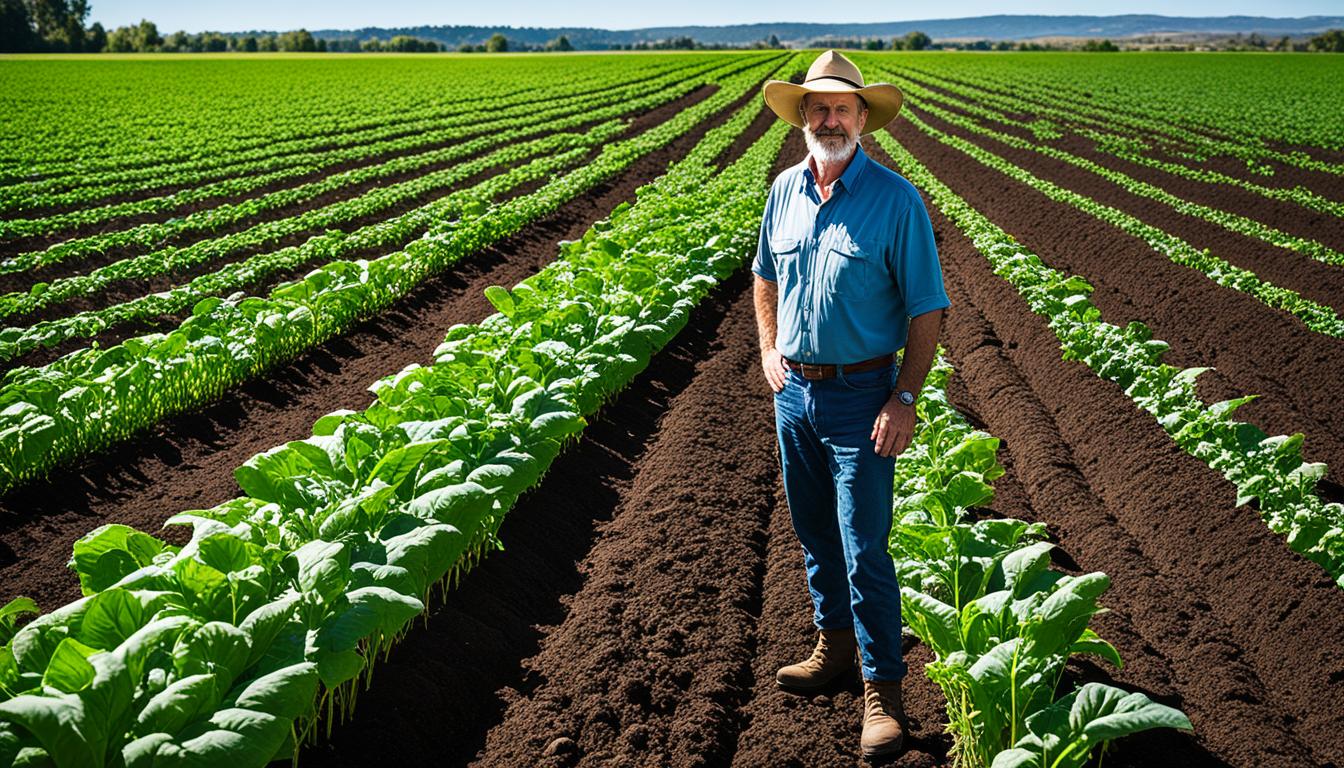
Tillage and other physical soil disruptions harm soil microbes and the essential food web. This important point shows why it’s crucial to take care of soil health for better farming results. Rich soil means successful crops. For example, using organic waste as a soil enhancer breaks down bad stuff and makes plants grow better.
Bioengineering, a mix of engineering and biology, boosts soil’s natural systems. It helps plants, like avocados, bear fruit faster. But, people don’t always agree on how to best improve soil. Some say focusing on the right mix of microbes works better than high-tech fixes. It’s key to remember that soil needs enough oxygen to stay healthy.
The health of soil is vital for farming to be sustainable. Nearly all food comes from the earth. It uses the soil to get nutrients and water. But, a lot of the world’s farmland is not in good condition. This harms over 2 billion people who don’t get enough nutrients. So, we must look after the soil to keep farming strong.
Nutrient cycling by the soil is vital for growing crops. It keeps important nutrients going to plants. This helps them grow strong and healthy. Soils rich in organic matter, and tiny living creatures, play a big part. They recycle dead plants and animals into food for new plants. This is key for a healthy, plant-growing environment.
Managing water in farming is very important. The quality of the soil affects how well it can hold or filter water. Healthy soil with lots of organic matter can store more water. It means less water runs off, and soil doesn’t wash away. Innovations like the systems Richland Micro Drainage offers help plants get the right amount of water. This keeps them growing well.
Certain tiny soil creatures are essential for good soil health. They help clean up harmful substances and fight off pests. They also keep the soil structure strong and full of nutrients. Farms like Norwich Meadows Farm take care to have lots of different types of these tiny creatures. This helps farming work well over a long time and keeps nature in balance.
Soil quality covers many features that help plants and animals thrive, keep the environment healthy, and support life. It is defined by Doran and Parkin (1994) as the soil’s ability to work naturally within its surroundings. Knowing about soil quality indicators is vital for good soil management.
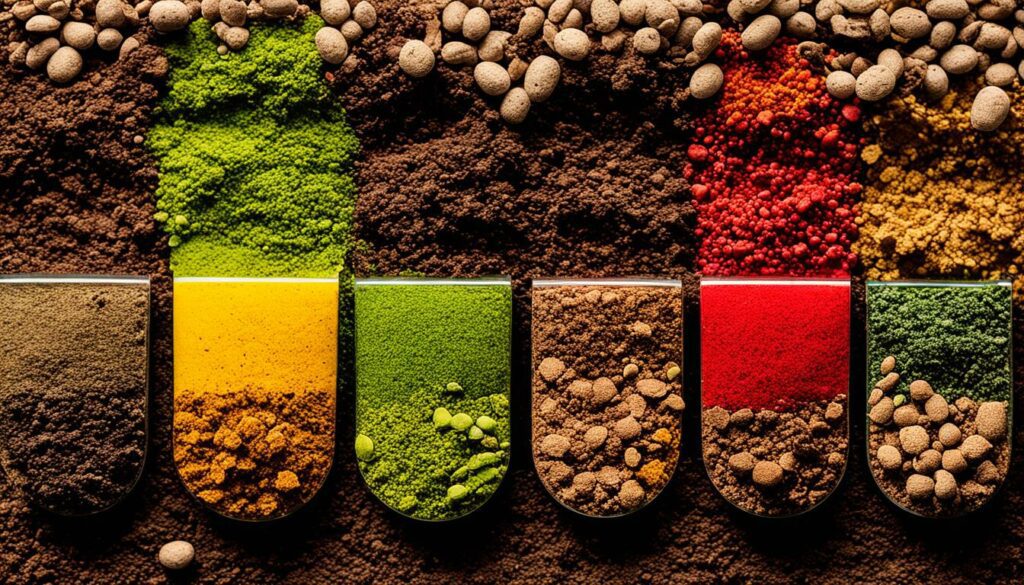
Soil texture, structure, and porosity are key to soil quality. They impact how well soil holds water and lets water in. A good soil structure and texture are great for plants; they help roots grow well and make it easy for plants to get the water and nutrients they need.
When soil has strong aggregates, it is less likely to get hard from being stepped on or treated too much. This is a big problem in farming.
Stuff like soil pH, EC, nitrate, and phosphate levels matter a lot for plant growth. Soil pH affects how well plants can get essential nutrients. This can change if the soil is not looked after right, leading to lower crop yields.
Carbon in the soil tells us about its health. It comes from things like dead plants and animals. Managing soil well means looking after these chemical properties.
Life in the soil is also super important for its health. Things like tiny creatures and helpful bacteria keep the soil in good shape. They help with soil structure, moving nutrients around, and holding onto water.
Earthworms do a great job too. They eat dead stuff, making the soil better for plants. This all points to a living, breathing world under our feet that we need to care for.
Assessing these aspects of soil is key to managing it well. By keeping an eye on these indicators, we can make the soil even better. This helps our plants grow strong and healthy, giving us good crops.
Sustainable farming is more than just a trendy phrase. It is a significant change in how we do agriculture. This change aims to work with nature for long-term productivity. Farmers are using methods like organic farming techniques, crop rotation, and cover cropping to make their fields better. They are doing this to grow more crops.
Organic farming is key to sustainable agriculture. It avoids using man-made chemicals. Instead, it uses natural stuff to keep the soil healthy. For example, planting cover crops like mustard and legumes helps the soil. It adds nutrients and stops soil from washing away. This natural approach boosts the variety of plants on a farm. It also helps save water, which is vital for growing good crops.
Crop rotation shows the great mix of old and new farming. By changing which plants are grown in each field, it fights off pests and diseases. This helps cut down on using chemicals. Different crops also feed the soil in different ways. This keeps the soil rich and helps crops grow better. Using less invasive ways to plant helps the soil get stronger too.
Cover cropping is becoming more popular for good reasons. It helps keep the soil rich by stopping it from washing away. In wet winters, it’s especially important. Cover crops, like mustard or a mix of grains and beans, help keep the land diverse. Healthy land is a home for good bugs. It also works well with how farmers usually do things. For instance, almond farmers in California use cover crops to keep the ground covered all the time. This shows it works well even with crops that grow year after year.
Using organic farming techniques, crop rotation, and cover cropping is changing agriculture. It’s creating a new, natural way to grow food. It’s good for the earth and makes sure we can keep growing food for the future. These methods are making agriculture better for everyone.
Keeping the soil healthy is key for good crops. It’s about making sure the soil has the right nutrients. And we do it in a way that’s good for the earth in the long run. Using natural fertilisers and watering methods are very important for this.
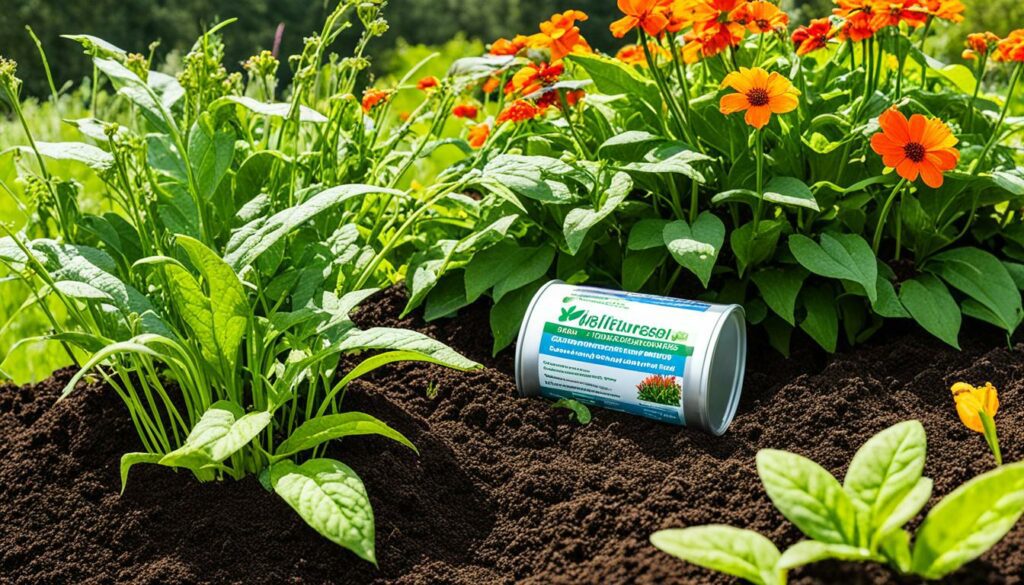
Nitrogen-fixing bacteria and mycorrhizal fungi are big helpers. They boost the soil’s health. With their help, plants don’t need as much man-made fertiliser. This is a green choice for farming, supported by the FAO and IAEA. It makes the soil richer, which means healthier plants and better crops.
Using water smartly is a must for good soil health. Richland Micro Drainage has smart water systems that help crops get just enough water. This prevents damage from too much or too little water. Managing water well helps keep the soil’s nutrient level right. By using clever ways to water along with natural fertilisers, farmers get the best results for their soil and crops.
Improving soil resilience is vital in sustainable farming, especially with climate change challenges. Methods like bioremediation and using organic materials help make soil healthier.
Bioremediation is key for removing harmful substances from soil. It uses tiny organisms to clean up and make the soil better. A big study found that good soil helps plants grow better even in hot weather. This shows how important it is to work on the soil to protect our environment.
Recent efforts to enhance soil quality in China have shown a potential to decrease crop production decline due to climate change by 20%.
Adding organic matter like compost and biochar makes soil stronger and more productive. These materials are full of good bacteria and minerals. They improve the soil’s texture, structure, and life. These practices help farming be more sustainable.
Using organic materials boosts the soil’s own good bacteria. This helps the soil deal better with tough situations.
| Soil Quality Indicator | Benefits |
|---|---|
| Soil Texture | Improved water holding capacity and root penetration |
| Organic Matter | Enhanced nutrient availability and microbial activity |
| pH Levels | Optimal plant growth and nutrient uptake |
| Soil Biodiversity | Increased resilience against pests and diseases |
Focusing on bioremediation and organic methods helps farming last longer and be kinder to the earth.
Soil oxygen levels are essential for good soil quality and healthy plants. They affect activity in the soil and the health of plant roots. Knowing how to keep these levels right helps in farming that cares for the environment.
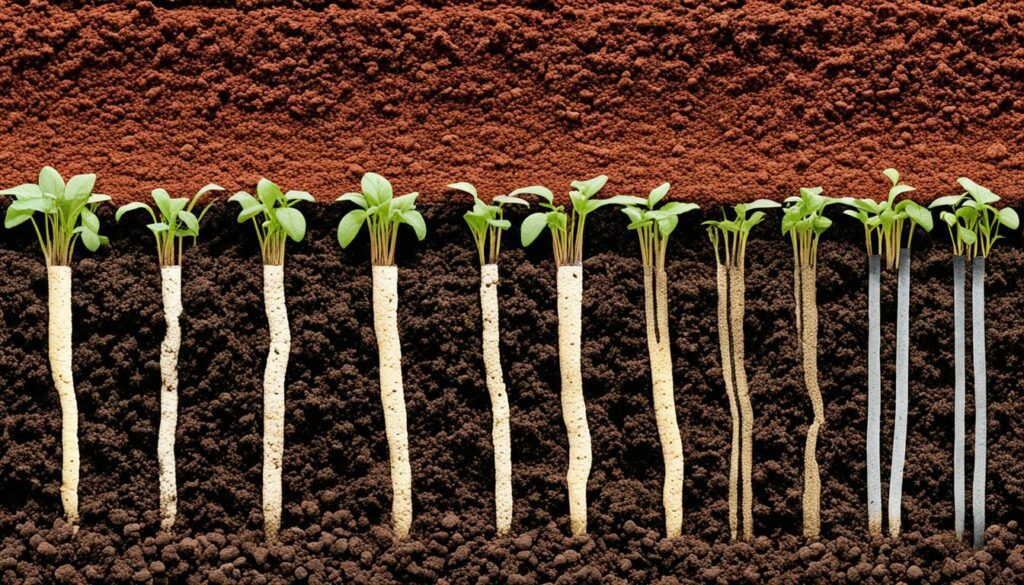
To check soil oxygen well, we use oxygen sensors. They go into the soil and tell us oxygen right there. We can also guess the oxygen from how much the soil ‘breathes’. If oxygen is too low, plants can’t grow. This hurts soil and the amount of food we can grow.
Making sure soil has enough air is key to stop oxygen problems. Over-watering or floods can make soil too wet and without enough air. This harms plant roots and the helpful microbes in the soil.
Steps like ploughing, adding natural materials, and not pressing the soil down help air get in. Being careful with watering keeps the soil from getting too wet.
Here are tips to make soil have better air:
| Parameter | Strategy | Impact on Soil Oxygen Levels |
|---|---|---|
| Soil Compaction | Reduced through tilling and organic amendments | Increases pore spaces, allowing better gas diffusion |
| Water Management | Optimised irrigation scheduling | Prevents waterlogging, ensuring adequate oxygen supply |
| Organic Matter Content | Balanced addition of organic materials | Regulates decomposition rates, preventing rapid oxygen depletion |
These steps help air move in the soil, making soil and plants healthier. This makes farms stronger and able to grow more food.
Advances in soil health monitoring tools are changing how we farm. They give us up-to-the-minute, accurate data on soil. This data helps farmers boost their crops and manage land better.
Biosensors are key for checking soil closely. They mix biology with the latest tech to measure things like how wet the soil is, its acidity, and what nutrients it has. Soil Spectra by Farmsys in India and N-Sense in the US are two examples. They keep an eye on the soil’s health with high-tech tools. Soil Spectra looks at moisture, heat, nutrients like NPK, and soil acidity. N-Sense focuses on watching the nitrate levels, using a method called Fourier-transform infrared spectroscopy.
Data collection tools are getting better, too. They make checking soil health even more accurate and helpful. Innovations like GPS Survey Rig and Point Stake Out grab detailed location data. With this tech, farmers can plan their soil care better.
There’s also TerraRad, from Switzerland. They use drones with special antennas to check topsoil moisture from above. And in the US, there’s Map My Crop. They mix their own smart math with satellite info to make maps showing how productive a piece of soil is.
| Startup | Technology | Specialisation |
|---|---|---|
| Farmsys | Soil Spectra IoT Sensor | Temperature, Moisture, NPK Ratio, Soil pH |
| N-Sense | Fourier-Transform Infrared Spectroscopy | Soil Nitrate Monitoring |
| TerraRad | Drone with L-band Radio Wave Antennas | Topsoil Moisture Sensing |
| Map My Crop | Proprietary Algorithms, Satellite Data | Soil Productivity Maps |
These advanced tools are changing how we take care of soil. By using biosensors and high-end data collection tech, farmers can make their land more productive and keep their soil healthier.
Improving soil health helps crops grow better, supports the environment, and boosts the economy. These changes are key for farming and our general well-being. Let’s dive into how it all works.
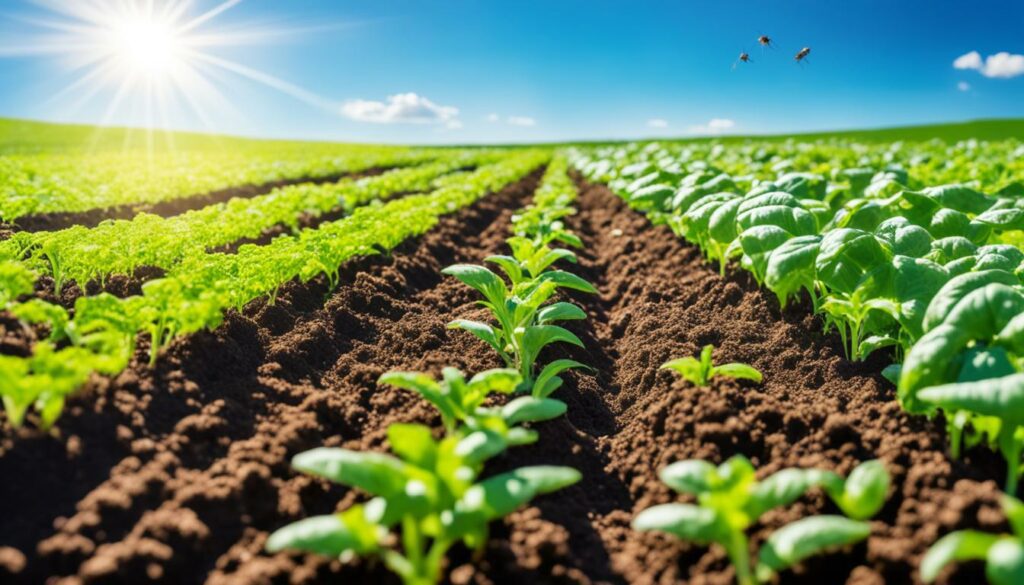
Soil health boosts the amount of food we can grow. It supports the nutrients and structure plants need. Better soil means more food, and farmers can earn more money. This helps make sure everyone has enough to eat and fights against vitamin shortages worldwide.
Better soil is good for the planet. Actions that improve soil health, like using cover crops and no-till farming, also help the earth. They lower soil erosion and keep nutrients where they should be. Plus, these methods help clean water and lock away carbon, which is good for fighting climate change. They also stop harmful chemicals from building up and hurting our ecosystems.
Good soil is good for business too. It lowers costs for farmers and helps them earn more money. By investing in soil health, farmers spent less on growing corn and soybeans. Their crops also stood up better to strange weather. This made their business more stable. So, focusing on soil is not just good for the planet; it’s smart for business too.
Bioengineering offers new ways to make soil healthier by using modern agriculture applications. It includes adding beneficial genes to crops to make the soil stronger and more productive. These new technologies are key in fighting soil degradation and aiming for better crop growth.
Bioengineering in farming is bringing amazing advantages. Biochar, made by bioengineering, is great for the soil. It helps in keeping the soil healthy. Also, using liquid soil nutrients from organic waste quickly shows improvements. Tools like biosensors help check soil health accurately, leading to better soil care.
Adding just the right soil microbes helps the soil work its best and increases fertility. Bioengineering also boosts oxygen in the soil. This is important for good bacteria and fungi, making the soil healthier.
But, bioengineering isn’t all good. It might cause issues with soil and nature. For example, adding foreign genes could harm the environment. This is why we need to check very carefully and have strict rules.
Lets talk about the bigger effects of bioengineered solutions. What will they do to wildlife and the soil’s balance? As we use more bioengineering in farming, considering these effects is crucial. Although bioengineering is promising, it must be used wisely and with care.
Eleven top experts stress the importance of watching soil quality closely with bioengineering. They say we need a careful mix of technology and good soil management.
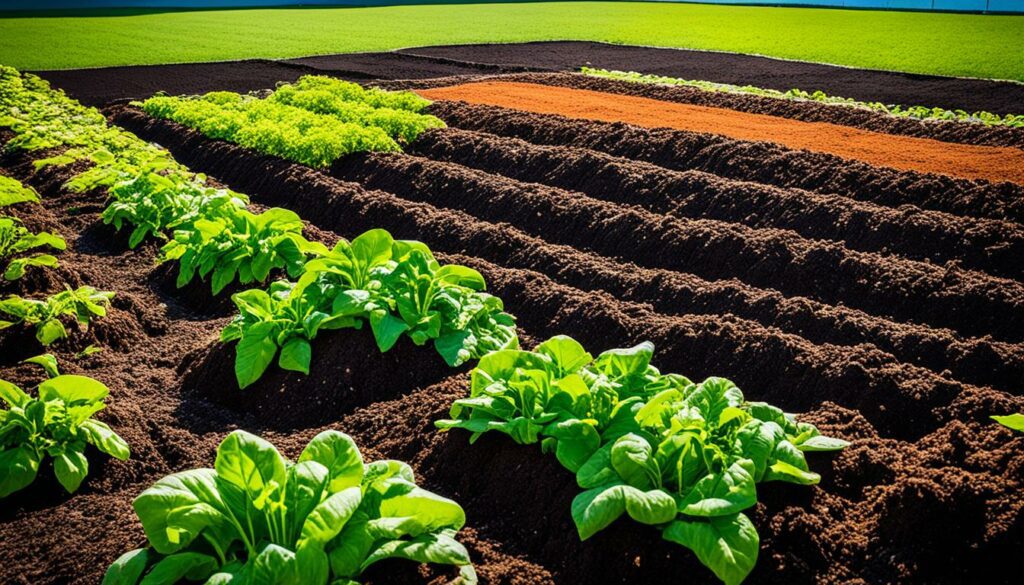
In moving towards sustainable farming, using compost is key. It is full of organic matter which helps the soil in many ways. This improves soil health, saves water, and supports sustainable farming.
Compost is mainly old, broken-down plant material. When added to soil, it makes the ground better for plants. It does this by increasing the space in the soil and its water-holding ability. This leads to healthier plants because it helps nutrients move and fights off plant diseases. Overall, it helps make a good living place for plants and other little organisms.
A study found that adding 5% to 10% compost to soil made it store more water. This was even when the soil was close to drying out. This is important for not using too much water when growing crops. Also, it helps capture carbon which is good for fighting climate change.
The way you add compost is important for it to work well. Making compost teas before adding the compost can improve the soil a lot. It makes a better place for roots to grow. Also, mixing the compost well into the soil helps spread its goodness evenly.
Making sure the compost is of high quality is crucial. Testing it ensures it does what it’s supposed to. For example, a study found that using the right kind of compost helped crops grow better. This is all part of good sustainable farming methods.
Using compost in farming helps a lot of life in the soil. It keeps the earth active for farming. In the end, compost is a powerful tool for making farms healthier and more able to deal with changes.
Cover cropping has become key in sustainable farming. It helps combat soil erosion and uplift soil health. This is crucial in the northeast United States, where heavy rains are common. These rains cause problems like soil erosion and nutrient loss. An increase in wet weather during spring and autumn means fewer working days for farmers each year. Thus, long-lasting farming methods like cover cropping are a must.
Cover cropping involves planting special crops to cover the ground. These crops help the soil by capturing leftover nutrients. They make the soil better at holding moisture. Cover crops *also* stop soil erosion, reduce nutrient loss, lower soil compaction, and can even keep some pests away.
Cover crops come in many types, each offering its own benefits. Legumes, such as clovers and vetches, add nitrogen to the soil. This enriches it for future crops. Grains and grasses, like rye and Sudan grass, improve the soil’s structure. Radishes are also great. They break up compacted soil, making it easier for roots and water to move through.
| Cover Crop Type | Primary Benefits |
|---|---|
| Legumes (Clovers, Vetches) | Nitrogen fixation, soil fertility |
| Grains (Rye) | Erosion control, soil structure |
| Grasses (Sudan Grass) | Soil structure, forage |
| Radishes | Soil Compaction, nutrient scavenging |
When you plant cover crops is crucial. It affects how well they can improve the soil. Autumn cover crops safeguard the soil from winter wear and tear. They also help keep moisture at good levels. In spring, these crops ready the land for main planting by making the soil better and nutrients more available. Good cover crop management boosts *crop yields*. It also promotes more biodiversity and better organic farming.
Cover crops are well-built into the farming calendar, especially for organic farms. They help handle soil nutrients better. Plus, they keep the soil alive with roots throughout the year. This supports good soil health and the life of helpful organisms.
Stopping soil erosion is key in keeping the land productive and green. Methods like contour farming and planting windbreaks help a lot. They keep the soil from washing away, making sure it stays healthy for years to come.
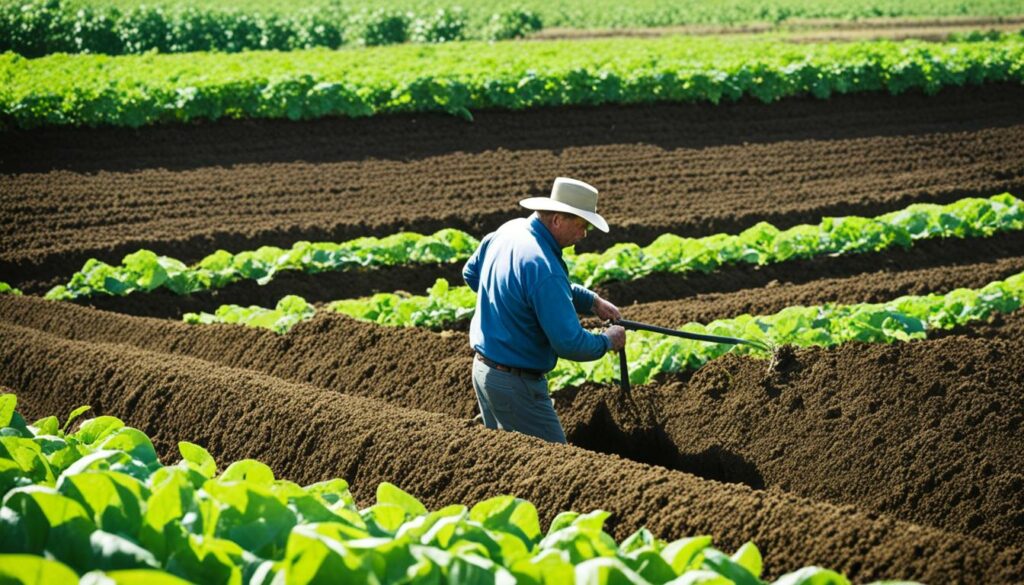
Contour farming is a smart way to use the shape of the land to fight erosion. By ploughing or planting across a slope, we reduce water run-off. This way, the soil stays in place and we keep the land fruitful.
No-till and reduced tillage help too by keeping the soil healthy and inviting to wildlife. But, we must be careful. Too much digging can remove the soil’s good parts, making it less fertile.
Windbreaks are crucial in caring for the soil. They’re made of rows of trees or bushes that slow down the wind. In the U.S., they slow the wind 20 times their own height. This stops the soil from blowing away in dry areas, helping to protect the land.
Areas without much rain in North America lose a lot of soil to the wind every year. Windbreaks act like shields, preventing the soil from moving. They play a big part in keeping the land healthy and productive.
Using cover crops further stabilises the soil, _especially in places where it rains a lot during winter_. Crops like triticale and cereal rye are great at reducing erosion. They also help the ground soak up water better. Planting a mix of different crops adds diversity to the earth. This helps the soil stay strong and fit for growing crops year after year.
Exploring soil biodiversity shows us how important a varied biome is for good crop growth. A mix of life in the soil helps recycle nutrients, fight off diseases, and keep the soil healthy. This is key for farming that lasts without harming the Earth.
A rich soil biome has several advantages. Many tiny creatures like bacteria and fungi play a part in making nutrients available and protecting crops. The FAO notes that preserving soil’s diverse life is vital for our planet’s future. It’s amazing to think each hectare of land might house over 13,000 different species, showing just how diverse and important soil life is.
Improving soil life through methods like planting different crops together or using cover crops is essential. These practices keep the balance of the soil’s living things and organic matter right, supporting a strong ecosystem. Better farming that protects the environment includes efforts to keep a healthy mix of soil life, manage water and pests well. Innovations like using sensors and nanotechnology are also helping, enabling us to use ‘good bacteria’ in the soil for healthier farming.
So, taking care of soil life is directly tied to how well our crops grow and how strong our farms are. By making sure our soil is full of different life, we’re working towards feeding the world and protecting our planet.
Managing soil well is key to getting the best yields from our crops. It requires a strategic mix of looking after the soil’s fertility, testing it thoroughly, and then adjusting our plans based on this. By doing this, we can see our crop yields rise significantly.
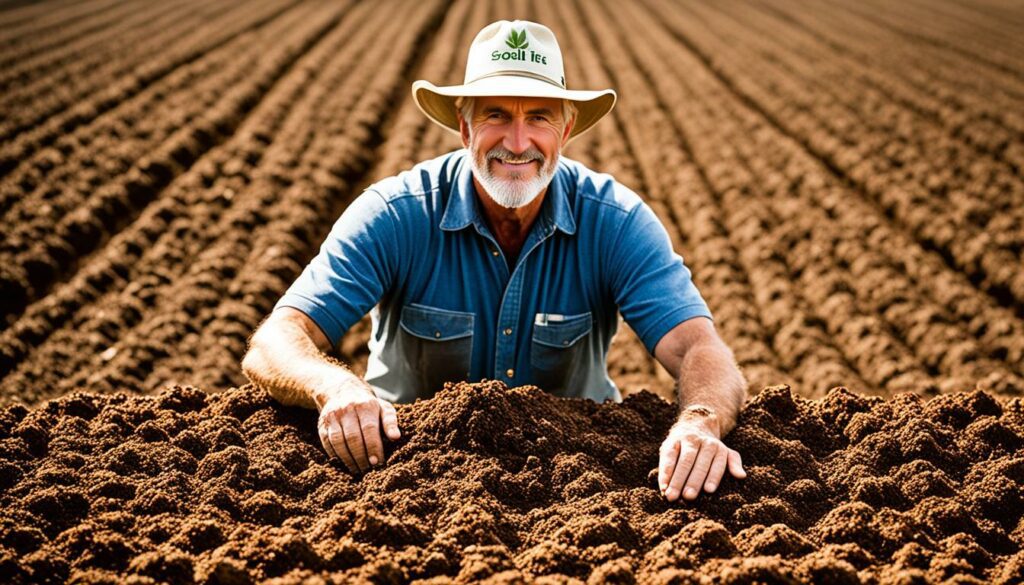
Integrated soil fertility management (ISFM) combines natural and artificial ways to keep the soil healthy for a long time. For instance, using things like compost and biofertilisers adds nutrients back to the soil and improves its structure. The proper care of soil nutrients through ISFM is often key to a successful corn harvest.
Testing the soil and analysing its results are important steps in caring for it. By checking the soil’s pH, its nutrient levels, and how much organic matter it has, farmers can learn what their soil needs to grow healthier crops. This approach helps to provide crops with the right nutrients they need.
“Regular soil testing offers a roadmap for precise soil management, enhancing both soil and crop performance.”
Testing also helps find and fix problems in the soil that might stop our crops from growing well. This method keeps the soil rich and helps us farm in a way that is better for the earth and our resources.
Richland Micro Drainage provides smart ways to control soil moisture, which is crucial for strong crop growth. Their selection of products, from surface drainage like the Model 24 Ditcher Terracer to underground tools like the Micro Plow, helps prevent too much water and soil loss. These ways of managing water support farming for the future by keeping the soil in great shape.
| Soil Management Strategy | Benefits |
|---|---|
| Integrated Soil Fertility Management | Enhances nutrient availability, improves soil structure, supports microbial activity |
| Soil Testing and Analysis | Provides precise data, informs nutrient application, improves crop productivity |
| Richland Micro Drainage Solutions | Enhances water management, reduces soil erosion, promotes sustainability |
The world is facing a big issue with soil loss. Around ~24 billion metric tons of soil are lost each year from erosion. About 30% of global soils are damaged. To tackle this, we need to use new technological innovations and strong policy and regulatory frameworks.
For the future of sustainable soil management, new tech is key. Biosensors and data analysis platforms are great for checking soil health closely. No-till methods, as shown by Ogle, Swan, and Paustian, can boost how much carbon soils keep and the yield of crops.
Norris and Congreves found that other farming methods can also improve soil health. Using tools like the GPS Survey Rig helps gather soil data accurately. This lets farmers improve soil care very specifically with up-to-date information.
The change in policy and regulatory frameworks is vital too. We’re in the International Decade of Soils (2015–2024) according to the United Nations. We need policies that push for new, eco-friendly practices and guarantee we meet environmental standards.
Soil health is essential for many of the United Nations Sustainable Development Goals. To protect soil, regulations must encourage new ideas and make sure soil is safe. In China, not all soils fit the quality standards, so strict rules are needed for repair and upkeep.
Governments and foreign help aren’t investing in farming like before. To keep working on sustainable soil management, we should encourage private and public partnerships more. Aligning tech advancements with the right policies can lead us to healthier soils and a farming future that’s better prepared for challenges.
Sustainable agriculture links closely with soil health and crop yield. This discussion shows how mixing traditional and modern farming is key to environmental health. With the growing global population, expected to reach 9.7 billion by 2050 (United Nations, 2017), we must enhance soil management to boost our farms’ output.
Approaches like no-tillage and continuous cropping are better for soil health than older methods. These newer ways have been shown to lead to healthier soil (Six et al., 2000; Halvorson et al., 2002; Sainju et al., 2015). Also, changing the types of crops we grow helps make soil more fertile (Lal et al., 1994; Liebig et al., 2002). This shows how mixing new ideas with the old can help our soil and crops thrive.
In summary, using smart tools to watch soil and farming carefully can help us meet future crop needs without harming the earth. As we adopt these varied techniques, from less tillage to mixing up crops, we build a future where soil’s condition is really important. This way, improving our soil and what we grow is crucial. It ensures we leave healthy land to those who come after us, supports farming, and encourages new ideas.
Healthy soil is key for plants to get essential nutrients for growth. It holds and moves nutrients well, like Cornell University explains. This helps plants get the nutrition they need.
Good soil health affects how well water gets into the ground and is stored. Richland Micro Drainage’s systems are top-notch for controlling soil moisture. They make crops grow better.
Good soil bugs fight off pests, break down toxins, and keep soil healthy. They’re crucial for farming, especially in places like Norwich Meadows Farm. There, they’re a big part of looking after the land.
Soil’s look, how it’s structured, and how well it lets water through show if it’s healthy. These factors tell us a lot about the soil’s well-being.
Soil’s acidity, how much organic stuff it has, and its nutrient levels are key. These show if the soil can help plants grow well.
Soil’s biological life, like its bugs and tiny plants, tells us how lively it is. This life helps keep the soil and plants healthy by recycling nutrients and fighting diseases.
Methods like planting different things each year and adding natural fertilisers improve the soil. They work with nature to keep the land healthy, without using too many chemicals.
Mixing up what’s planted helps fight off harmful bugs and makes soil richer. This method really helps the land stay healthy and productive.
Plants like mustard or alfalfa are grown between money-making crops. These help the environment, save water, and make farms more diverse.
They’re like plant health food, making more nutrients available in the soil. This makes plants stronger and they can fight off diseases better.
Using water right stops the soil from being too wet or dry. Good systems, such as those made by Richland Micro Drainage, really help plants grow well.
By using tiny living things, bioremediation cleans up bad soil chemicals. It’s a key part of keeping farms healthy and safe for the future.
Adding things like compost makes the soil and its helpful microbes stronger. This helps the land deal with tough situations better.
Special tools, such as soil oxygen sensors, check how much air the soil has. This helps us understand how healthy the soil is.
Breaking the soil up and adding certain things help it ‘breathe’. This is vital for keeping roots healthy and encouraging the right kinds of life in the ground.
Biosensors use technology and science to figure out soil health. They look at things like how wet the soil is and if the earth is acidic. This helps farmers know what the soil needs to be healthy.
Tools like GPS help farmers learn a lot about their soil. This knowledge lets them take special care of the earth, so crops grow well.
Soil is happier, crops grow better, and the planet is healthier. Plus, it saves money and helps fight against bad weather.
Adding helpful genes to plants can make soil healthier. But, we need to be careful and think about the risks and if it’s right to do.
Bioengineering can have bad surprises for the soil and the environment. We must think hard about the effects on nature and for the long term – if it’s really the best choice.
Compost makes soil more fertile and full of life. It increases how many crops we can grow and keeps the land strong.
Making special teas with compost before using it enriches the soil even more. This simple trick can do wonders for plants and the land.
Plants like clovers, vetch, rye, and Sudan grass are great for the soil. They slow down erosion and add goodness back into the land.
We plant cover crops when cash crops aren’t growing. This helps the soil by putting natural nutrients back in and stopping erosion.
Ploughing and planting along the land’s natural lines stops soil from washing away. It’s smart farming that keeps soil healthy.
Windbreaks block the wind, so soil doesn’t get blown away. They’re an eco-friendly way to keep the land in good shape.
Many types of soil life mean the earth is rich in nutrients and disease fighters. This mix keeps the soil and plants strong.
Making compost and planting cover crops are great for soil bugs. They make the land a better place for plants to grow.
It’s about using both natural and man-made ways to keep the soil rich. This makes sure the soil gives the best food to plants.
By testing the soil, we can know exactly what it needs. This helps farmers use the right stuff to make the soil better for plants.
Modern tools help us understand and care for soil better. This means healthier land, more food, and a brighter future for farming.
Rules and policies keep farming safe and clean. They make sure we farm in ways that are good for the soil and the planet.